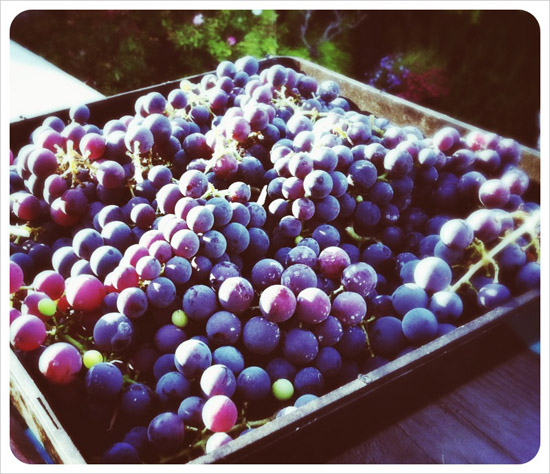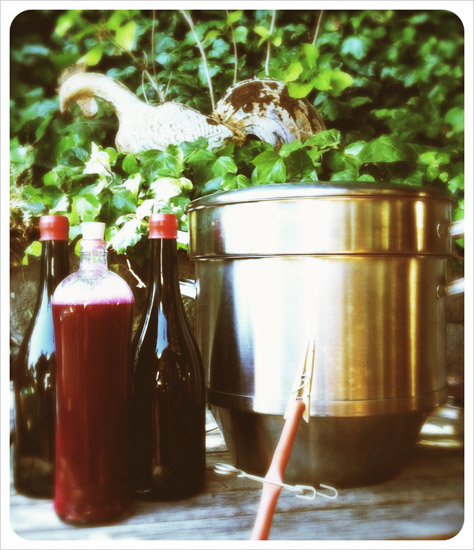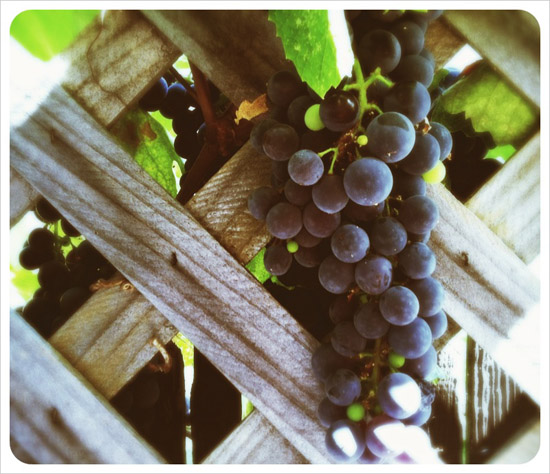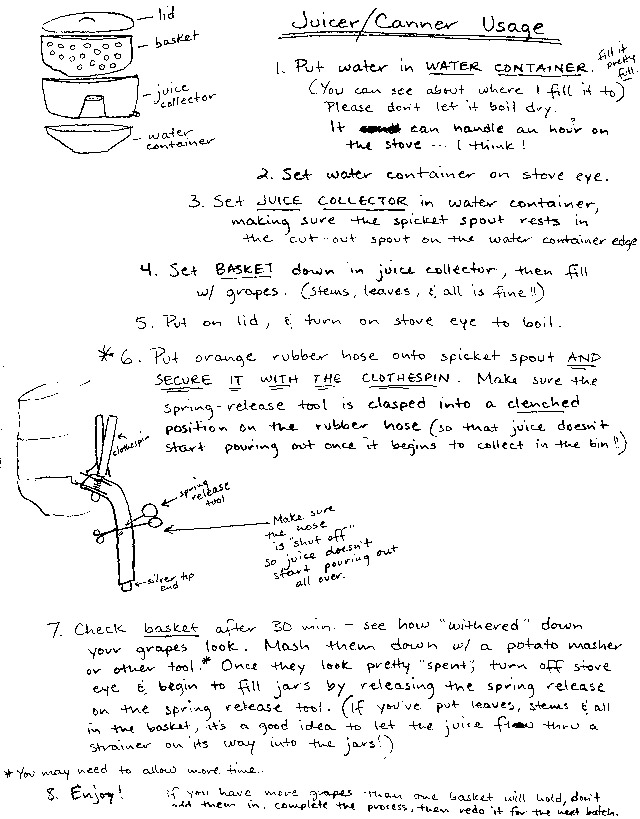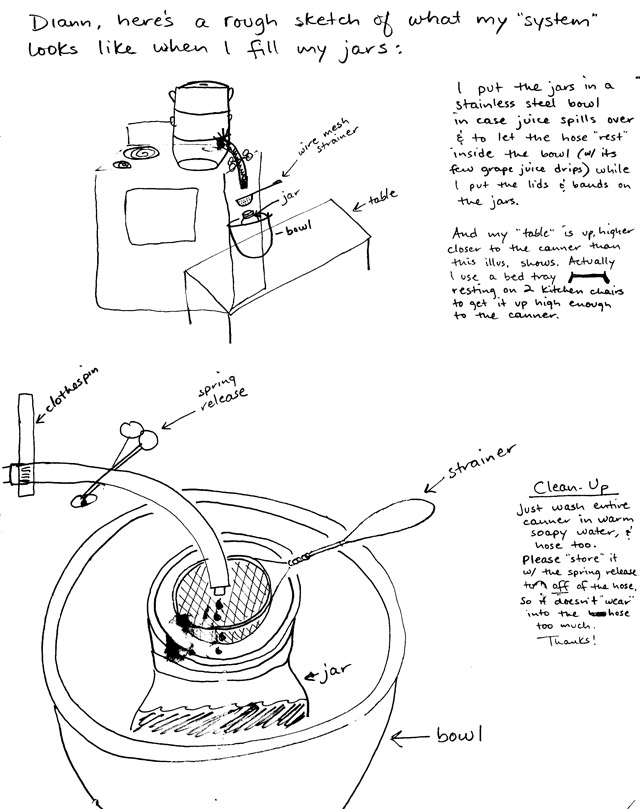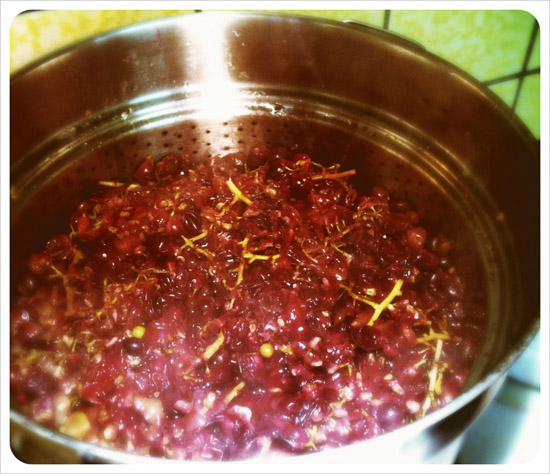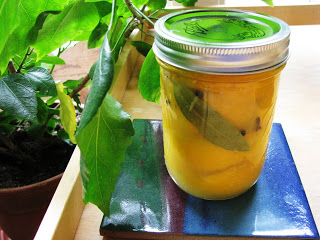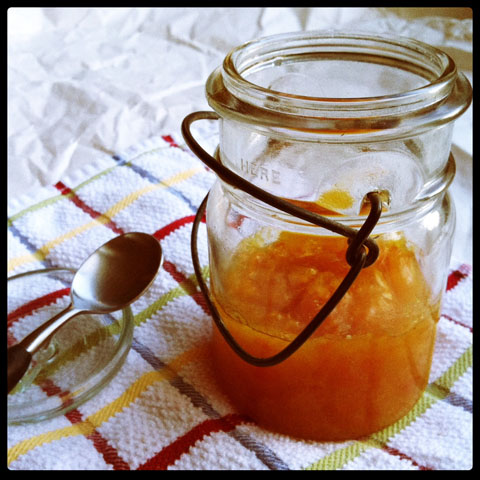A couple of weeks ago I got an urgent phone message from my mother. She said, “Call me back as soon as possible so we can talk about grapes.” (At this time of year it can be like a hotline for abandoned fruit around here, with people calling or emailing to say, “I have way too much such and such. Can you come get it?” It’s a problem every jam maker should have.)
The story is that the neighbors’ grapes have been going to waste every fall for almost a decade, since the family’s older generation stopped making wine and moved back to Portugal. The grapes were ripe and draping and dropping everywhere, perhaps as many as 200 pounds of them.
I tried to turn them down. I said I didn’t have time. I said I’d just brought home fifty pounds of quince, was swamped with work, and can’t possibly take care of every local fruit in need. (Am I convincing you?) She said, “Well, when you come over, maybe you can just look at them.” She knows me too well. It was like asking s0meone to “just look” at a cute puppy — or baby pigeon, in my case — in need of a home. The grapes were so beautiful! Dark, heavy, and sweet inside a skin that was tart and a little bit thick. I’ve only ever bought grapes from the grocery store; it was my first opportunity to harvest them — in this case, from a grotto of vines tangled around an extended arbor, so that you walk underneath and reach up to cut them down, enveloped in shade and a strong grape perfume.
No one knows what kind of grapes they are. Way back, they came from a slip obtained from a man who’d obtained a slip from someone else. My mom planned to take some to the new winery in town to see if they could help with identification. Meanwhile, we didn’t have to know what variety they were to make them into a wonderful grape juice.
Last spring, I bought that contraption above — a Mehu-Liisa steam juicer, made in Finland — on eBay. I was inspired to do this because Gloria Nicol — jam maker, photographer, and writer at the beautiful Laundry Etc. — had posted on Facebook that she had done the same in the UK, shaving the price by about half. In fact, when I wrote to Gloria to tell her that I had secured my own juicer on eBay for a great price, she committed an act of spontaneous generosity and sent me an extra rubber tube (mine was missing the original) and a little baggie of rubber bottle caps to get me started. This enthusiasm for sharing has always been at the foundation of our informal network of jam-making, fruit-loving bloggers, and it continues to be one of the very best good things about doing this work.
The steam juicer is a wonder. I took it to my folks’ house and my father and I knocked off a couple batches of grape juice in a few hours, while also making and eating dinner. The juicer comes with a manual that gives clear instructions for using it, along with a lot of recipes, but mine included a bonus. The woman who owned it before had written out her own instructions for a friend, complete with detailed drawings, and these came along with the juicer when I bought it. I love finding stray bits of documentation like this, and I’ve been looking forward to posting these for months . . .
My favorite tips from her notes are these:
- Secure the tube to the juicer with a clothespin.
- Make sure the “spicket spout” rests in the notch that is cut out in the water container for that purpose.
- Find a table that’s the right height for filling your bottles or jars and bring it over to the stove when the juice is ready.
- Put a bowl under your bottles or jars to catch any spills. (Trust me, you will be glad you did this.)
- Remember to take the clamp off the tubing when you store the juicer, so it doesn’t wear into the tube too much.
The other great thing is that her instructions were written specifically for grape juice, so she talks about how long to cook the grapes, what to look for, and so on. Here’s a recipe combining the instructions from the manual, some helpful notes from the anonymous former owner, and my own experience.
Homemade Grape Juice for the Mehu-Liisa Steam Juicer
Makes about 2 quarts or three recycled 750 ml wine bottles of juice
5 1/2 pounds grapes
1/3 cup sugar (vary according to your taste and the sweetness of the grapes, or make it without added sugar if you prefer)
1. Sterilize your containers — bottles, mason jars, rubber bottle caps, or lids. You may use whatever containers and method you prefer for this. I did it European-style, following the instructions in the manual. I thoroughly washed several 750 ml wine bottles and set them upright on a baking sheet in a 200 degree oven for the period of time that the grapes were steaming. Then, using a padded glove, I removed the bottles from the oven as we were ready to fill them. Whether you use rubber bottle caps or traditional two-piece lids, you can sterilize those by putting them in a bowl, covering them with simmering water, and letting them stand until you need them.
2. Fill the water container, put it on the stove, and set the juice kettle on top of it. Put the clamp on the rubber tube (!) and make sure the tube will not come in contact with the stove burner.
3. Rinse the grapes and put them into the steamer basket, stems and all. Set the steamer basket into the juice collector, sprinkle the sugar over the top of the grapes, and cover. Bring the water to gentle boil and let the grapes steam for about an hour. First, the skins will pop, then the grapes will turn color and slowly reduce until they are almost spent of juice. Check them and mash with a potato masher a couple of times. You may also want to check the water level toward the end of the process, to make sure there is no risk of cooking the basin dry. (If you fill it enough to begin with, you should have more than enough water to steam for an hour.)
4. When the juice is ready, place a sterilized, hot container under the spigot and release the clamp to fill it. We put a funnel in the bottle and set a strainer into the funnel to catch any stray bits of skin, stem, or leaf. The juice will be very hot when you fill the bottles, so take care not to burn yourself. If the juice goes into the bottle at a temperature of at least 190 degrees, there will be no need for further processing. Just cap the bottles as you go. As the juice cools, the rubber tops will be sucked down, and you’re all done. If your juice is below temp or you feel more secure processing with a hot water bath, use mason jars and process for 15 minutes. For wine bottles, leave about an inch of headspace. For mason jars, 1/4-inch will do.
**********
P.S. The story of our grapes ended with an unexpected twist. My parents enjoyed the grape juice so much that they decided they wanted to make as much as they could to keep for the year. The neighbors had always invited them to take an unlimited number of grapes, because the fruit is usually cut down and discarded unused — so sad. I brought the juicer back to my mom’s house, but the very morning she was going to harvest more grapes, a pickup truck appeared in the driveway next door, and a Portuguese-speaking man pulled two big plastic barrels from the back. He cut down and took away all the grapes! My father went over to say hello and learned that the man was going to use the grapes for wine, which is great, but the timing is kind of ironic. Next year, we’ll have to act faster.

